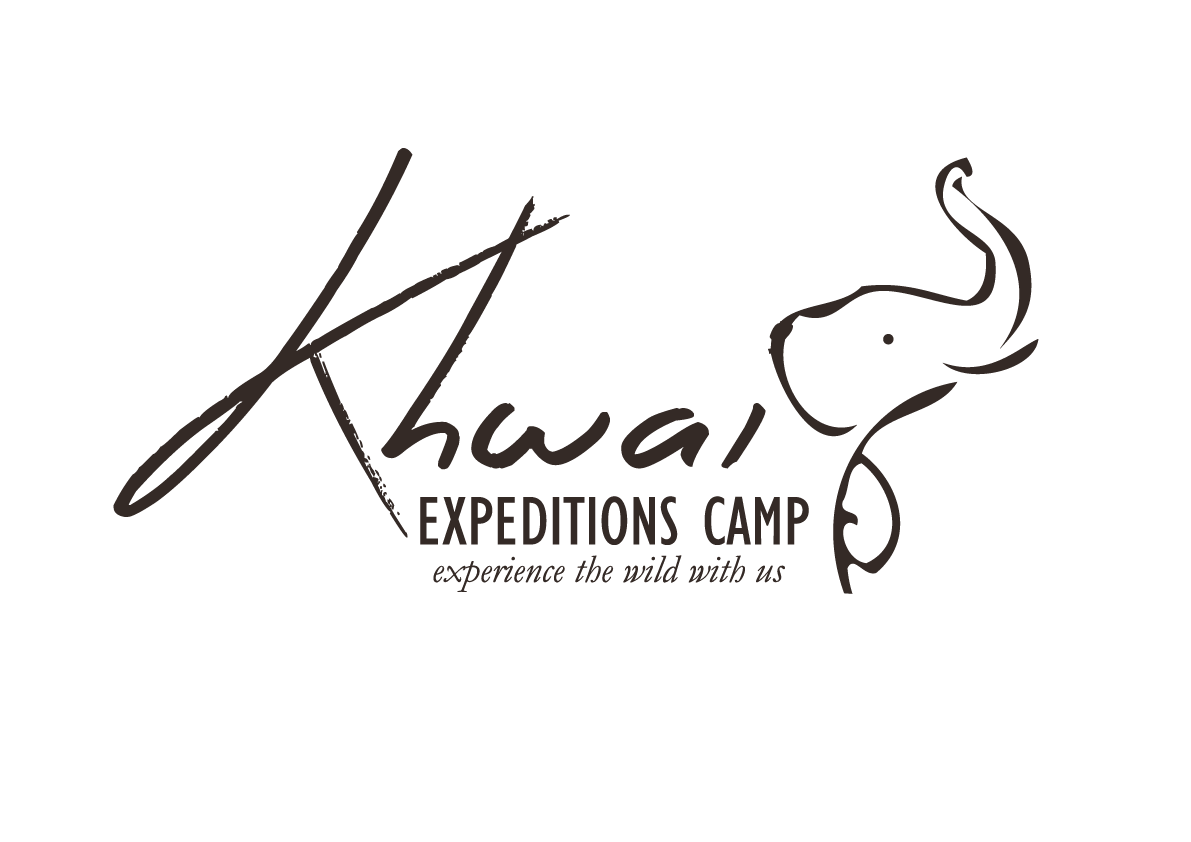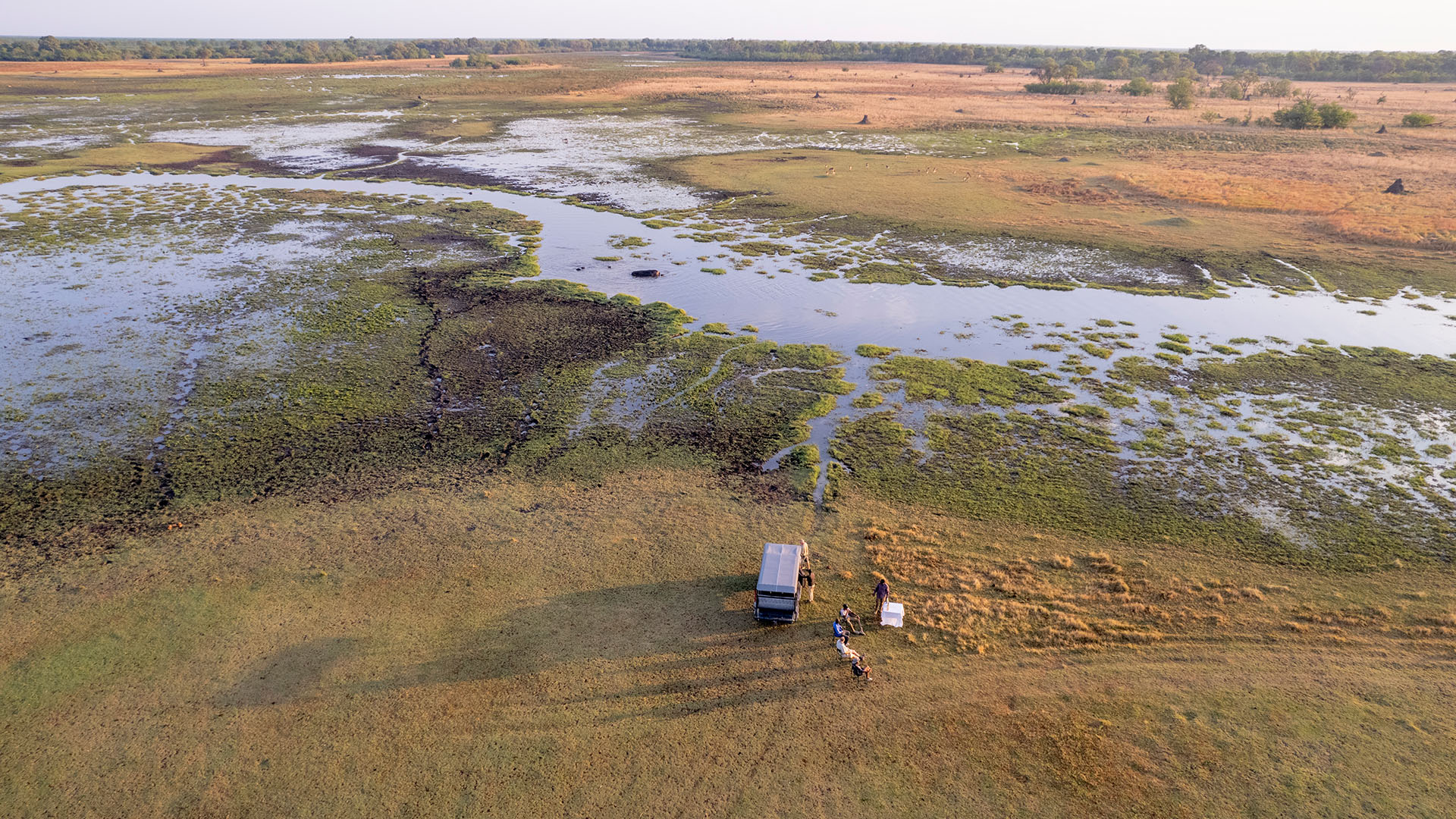The Okavango Delta is one of Botswana’s best safari destinations. This natural wonder stands as a testament to the raw beauty and untamed wilderness of the African continent. From its origins in the Angolan highlands to its vast floodplains and labyrinthine waterways, the Okavango Delta is a landscape of unparalleled diversity and ecological significance. Over 100,000 travelers get to enjoy this marvelous creation each year to witness incredible wildlife with some being the most sought-after species including The Big 5.
The Okavango Delta is the largest inland Delta in the world. Each year, the Okavango River pours about 11 cubic kilometers (equivalent to 1.1 million liters) of water into the Okavango Delta. Most of this water is lost: 60% is absorbed by plants, 36% evaporates, only 2% replenishes the aquifer, and the rest flows into Lake Ngami.
In our Ultimate Guide to the Okavango Delta, we invite you on a journey of discovery through this pristine wilderness. From the majestic elephants that shape its landscape to the vibrant birdlife that fills its skies, the delta teems with life at every turn. Whether you’re an intrepid adventurer, a wildlife enthusiast, or simply seeking solace in nature’s embrace, the Okavango Delta offers an experience like no other.
Geography and Ecology of the Okavango Delta
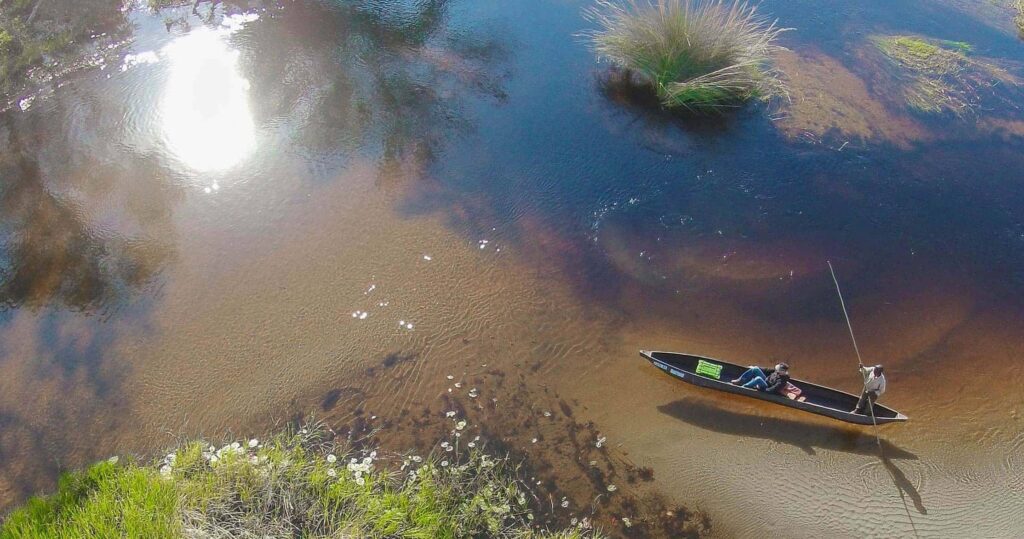
The geography of the Okavango Delta is unique and fascinating. Instead of flowing into an ocean or lake like most deltas, the Okavango River empties into the arid Kalahari Basin, creating a vast wetland ecosystem.
This delta is characterized by its diverse range of habitats including floodplains, swamps, marshlands, lagoons, and islands. These interconnected ecosystems provide a home for a wide variety of plant and animal species.
One of the most intriguing aspects of the Okavango Delta is its constantly shifting landscape. While parts of the delta are permanent, other areas experience annual flooding during Botswana’s dry season. This flooding occurs because of heavy rainfall in Angola, which causes the river to overflow and spread out across the delta.
This phenomenon attracts wild animals from far and wide, as they are drawn to the abundant water and vegetation that emerges during this time. It also creates ever-changing channels and waterways throughout the delta, making it an adventurous destination for exploration.
The geography and ecology of the Okavango Delta make it a truly remarkable natural wonder. Its unique formation as a landlocked delta and its annual flooding create an ever-changing landscape that supports an incredible array of plant and animal life. Whether
The History of The Okavango Delta
The story of the Okavango Delta begins with the Okavango River, originating from the Angolan highlands and winding its way through Namibia’s Caprivi Strip before finally reaching Botswana’s Kalahari Desert. Every year, this lifeline pours approximately 11 cubic kilometers of water into the delta, sustaining its vibrant ecosystem.
The Okavango Delta, located in the north-western part of Botswana, is a massive inland river system spanning approximately 16, 000 sqKm, roughly the size of Rhode Island. What sets it apart is its unique formation: unlike most deltas that empty into oceans, the Okavango River flows into a shallow basin within the sands of the Kalahari Desert, flooding the surrounding savannah.
This remarkable landscape took shape around 60,000 years ago due to tectonic plate movements in southeastern Botswana. These shifts altered the course of the Proto-Limpopo River, which we now know as the Okavango River. As a result, the river’s flow was impeded, creating the expansive alluvial fan that defines the delta today, extending northeastward from its source.
The delta’s landscape is a patchwork of islands, both large and small, formed by the intricate dance of nature. Termites, the unsung heroes of the delta, play a crucial role in this process, constructing islands that dot the watery expanse. Chief’s Island, the largest of these islands, stands as a testament to the forces of nature, formed upon a tectonic fault line.
Seasonal Flooding: The Pulse of Life
At the heart of the Okavango Delta’s enchantment lies its seasonal flooding, a phenomenon that shapes the very rhythm of life in this pristine wilderness. Each year, as the Okavango River swells with the waters of the Angolan highlands, it breathes new life into the arid plains of the Kalahari Desert, transforming them into a lush oasis teeming with biodiversity.
From March to June, the delta experiences its annual flood, reaching its peak in July. This natural spectacle coincides with Botswana’s dry season, drawing wildlife from the parched hinterlands to the delta’s fertile shores in search of water and sustenance. As the floodwaters recede in the following months, they leave behind a patchwork of channels, lagoons, and islands, each a vital lifeline for the myriad species that call the delta home. It’s also one of the best times to experience water-based activities.
For visitors to the Okavango Delta, this seasonal ebb and flow offer a unique opportunity to witness the drama of nature unfolding before their eyes. Whether gliding silently through the maze of waterways in a traditional mokoro canoe or embarking on a thrilling game drive in search of elusive predators, experiencing the delta’s seasonal rhythms is an adventure like no other.
As you explore the Okavango Delta, keep an eye out for the telltale signs of the flood’s passage – from the vibrant greenery that carpets the landscape to the diverse array of wildlife that congregates along its banks. And remember, each visit to the delta offers a fresh perspective on this dynamic ecosystem, ensuring that no two experiences are ever the same.
Wildlife Wonderland

The Okavango Delta is a true paradise for wildlife enthusiasts. With its rich and diverse ecosystems, this pristine area is home to an incredible variety of game.
From elephants and lions to hippos and crocodiles, the delta offers a chance to see some of Africa’s most iconic animals in their natural habitat. Furthermore, due to the strict conservation efforts in place, these precious species are protected from threats such as poaching or habitat destruction.
One of the remarkable aspects of the Okavango Delta is that it attracts both permanent residents and migratory species. Many animals, such as leopards and wild dogs, call the delta their home year-round.
However, during certain seasons, additional species make their way to the delta to take advantage of its abundant resources. This seasonal influx creates a dynamic and ever-changing ecosystem that ensures there is always something new and exciting to observe.
Birdwatchers will delight in the delta’s avian diversity, with over 530 species gracing its skies. Mammals, reptiles, and plants also thrive in this biodiverse haven, making every excursion a journey of discovery.
Thanks to the focus on conservation and wildlife management in Botswana, the Okavango Delta has become one of Africa’s premier destinations for wildlife viewing. Visitors have an opportunity not only to witness a wide array of animals but also to appreciate the efforts made towards preserving their natural habitats.
Whether exploring on foot, by safari vehicle, or mokoro (a traditional canoe), experiencing the Okavango Delta’s wildlife wonderland is an unforgettable experience.
The Okavango Delta Key Species
Several key species, including the African elephant, hippopotamus, and termite, play pivotal roles in shaping the delta’s ecology. Elephants, with their immense size and strength, carve pathways through the landscape, creating channels that allow water to flow further into the delta. Meanwhile, Hippos maintain vital waterways, preventing vegetation from clogging the delta’s arteries.
Termites, despite their diminutive size, are the architects of the delta’s islands, crafting intricate mounds that support a wealth of plant life. These eco-system engineers are essential to the delta’s delicate balance, ensuring its continued vitality.
Elephants: Eco-System Engineers
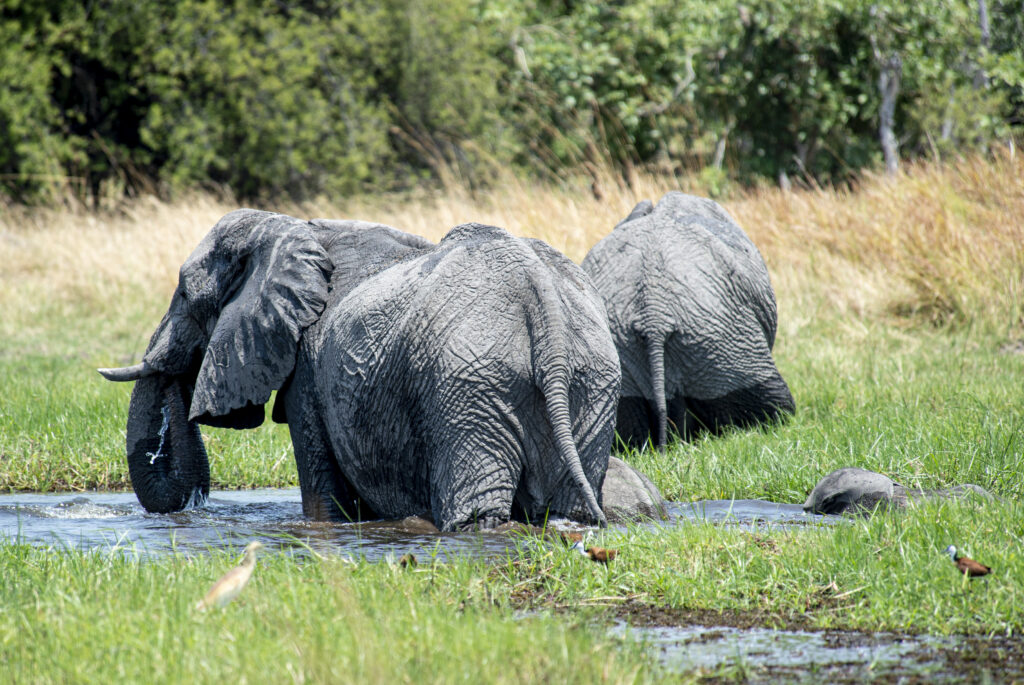
Botswana is renowned for having the largest elephant population in Africa. These majestic creatures play a vital role in the ecosystem, and their presence is integral to the balance of nature. They are not only magnificent to behold but also serve as key indicators of a healthy environment.
Without elephants, the description of Okavango Delta wildlife would be incomplete. The delta, located in northern Botswana, serves as a permanent home to these gentle giants, who roam freely and leave their mark on this breathtaking landscape.
However, it’s important to note that the population of elephants in the Okavango Delta varies throughout the year. During the rainy season, when water levels go up and fill the delta’s channels and lagoons, vast herds of elephants migrate here from different parts of Botswana.
They are drawn by the abundance of water and lush vegetation that thrives during this period. As they move en masse through this wetland oasis, the sheer power and grace of these animals make for an awe-inspiring sight.
In contrast, during the dry season when water becomes scarce and vegetation retreats into dormancy, these majestic creatures disperse into other areas of Botswana. Their knowledge and adaptation to navigate through their vast territory enable them to find alternative sources of sustenance outside the delta.
Hippos: Building the Delta’s Water Channels
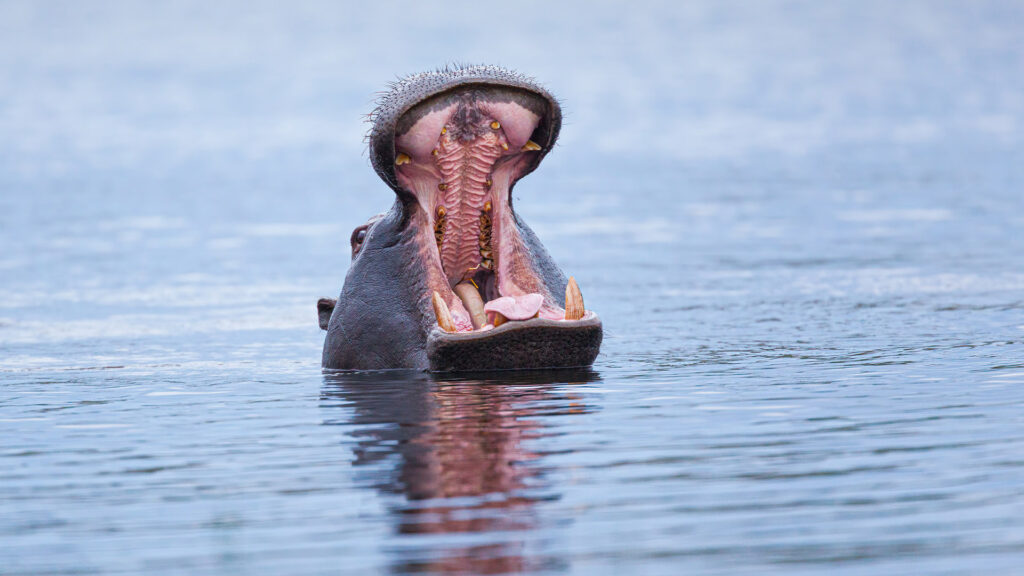
Another iconic species in the Okavango Delta is the hippopotamus. These enormous semi-aquatic mammals spend most of their days submerged in water, only emerging at night to graze on land. They are known for their distinctive grunting vocalizations and territorial behavior.
The hippopotamus plays a vital role in the conservation and preservation of the Okavango Delta’s ecosystem due to its ability to aid in the opening of water channels.
Often referred to as the “Okavango ecosystem engineers,” hippos use their immense size and strength to clear away vegetation that could potentially clog waterways.
This important task ensures that water can flow freely, preventing any rerouting or blockages that could disrupt the delicate balance of the Delta.
In the past, there have been instances where the absence of hippos led to significant consequences for the Okavango Delta. For example, at the beginning of the twentieth century when hippos were heavily hunted, their scarcity resulted in neglected canals and a lack of maintenance.
As a result, water began to flow in the opposite direction from its natural path, triggering a dry spell in southwestern areas that depended on this water source. This emphasizes how crucial hippos are in sustaining not only their habitat but also supporting surrounding ecosystems within the Delta.
Hippos are truly remarkable creatures to witness in person. With their enormous size and powerful physique, they capture attention wherever they go. Their sheer presence is awe-inspiring and serves as a testament to their importance as a keystone species in their
Lions: Pride and Territorial Control
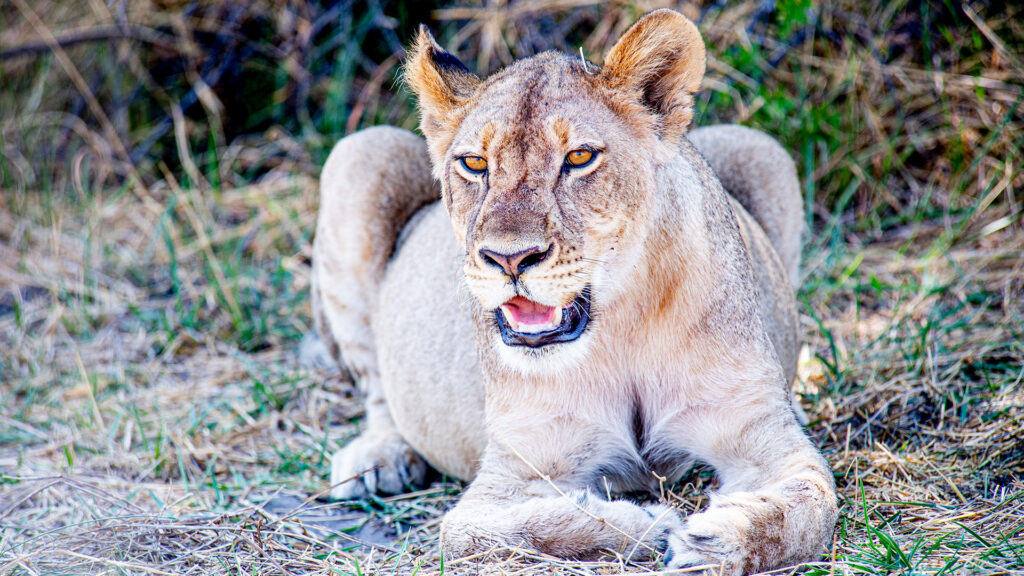
The Okavango Delta is renowned for its population of African lions, making it a prime destination for wildlife enthusiasts. These majestic creatures are highly sought-after sightings during safaris in the delta.
What sets the lions of the Okavango Delta apart is their impressive size and hunting skills, which have been honed through generations of survival in this unique ecosystem. Their adaptation to the delta’s environment has allowed them to thrive and become formidable predators.
African lions are known for their social nature, with pride being their trademark group. In the Okavango Delta, these prides can range in size from just a few individuals to as many as 30 lions.
The pride primarily consists of related females and their cubs, while one or more males take on the role of protecting both the pride and its territory. This social structure enables cooperative hunting and ensures the survival and well-being of each member.
One intriguing feature that distinguishes the lions in the Okavango Delta is their ability to swim. Living in a wetland ecosystem like the delta demands exceptional adaptability, and these lions have developed a skill set that allows them to navigate through water bodies effortlessly. Their swimming prowess not only aids in crossing rivers and channels but also gives them an advantage in catching prey that seeks refuge in water.
The presence of lions in the Okavango Delta is crucial for maintaining a balanced ecosystem. As apex predators, they regulate the population of herbivores such as zebras and wildebeests. This helps prevent overgrazing and ensures the survival of vegetation, which in turn supports other species within the delta.
Lions also play a vital role in keeping the herbivore population in check, which helps maintain a healthy balance within the predator-prey dynamics of the ecosystem.
Termites: Building Islands Across Waterways
The Okavango Delta is renowned for its stunning beauty, with lush green islands scattered across the water. What many people may not realize is that these islands were built by termites.
These tiny creatures, though often regarded as pests, are incredible engineers responsible for constructing 70% of the Okavango Delta islands. Without them, the beautiful trees and vegetation that adorn these islands would cease to exist.
Termites play a vital role in supporting the ecosystem of the Okavango Delta. Not only do they create a habitat for themselves within their intricate mounds, but they also provide food for many other animals.
Reptiles and birds rely on termites as an important source of nutrition. The termites’ integral role in the food chain highlights their significance in maintaining biodiversity and promoting a healthy environment.
Furthermore, termite mounds are one of the most distinctive features of the African landscape. They stand tall and proud, showcasing the termites’ social structure and ability to work cooperatively.
The mounds are meticulously constructed with minimal separation between body parts, distinguishing them from ants with a more pronounced “waist.” The size and function of these termite mounds are a testament to the remarkable capabilities of these tiny creatures.
Exploring the Delta
There are various ways to explore the Okavango Delta, each offering a unique perspective on this remarkable ecosystem. One popular option is to embark on a game drive, either in an open safari vehicle or on foot with an experienced guide. This allows visitors to get up close and personal with the wildlife, providing exciting opportunities for photographing and observing animals in their natural habitat.
Another popular choice is to take a mokoro ride, which is a traditional dugout canoe. Gliding silently through the delta’s waterways, visitors can witness the beauty of the landscape and have a chance to spot wildlife along the banks. This serene and peaceful experience offers a different perspective on the delta’s ecosystem.
For those seeking a more adventurous experience, there are options for guided walking safaris or even helicopter tours, providing a bird’s eye view of the delta’s stunning landscapes. Whichever method of exploration you choose, you can be sure that the Okavango Delta will leave you in awe of its natural beauty and abundant wildlife.
Things to Do in Okavango Delta: Safari Adventures
Embark on a journey like no other with a safari through the Okavango Delta. Explore the waterways by mokoro, traditional dugout canoes that glide silently through the reeds. Boating safaris offer a chance to encounter hippos and elephants up close while walking safaris provide a more intimate connection with the wilderness.
For those seeking a traditional safari experience, game drives offer the opportunity to spot Africa’s iconic wildlife against the backdrop of the delta’s stunning scenery. Horseback safaris provide a unique perspective, allowing visitors to traverse the delta’s landscape in the footsteps of explorers past.
Okavango Delta Mokoro safaris
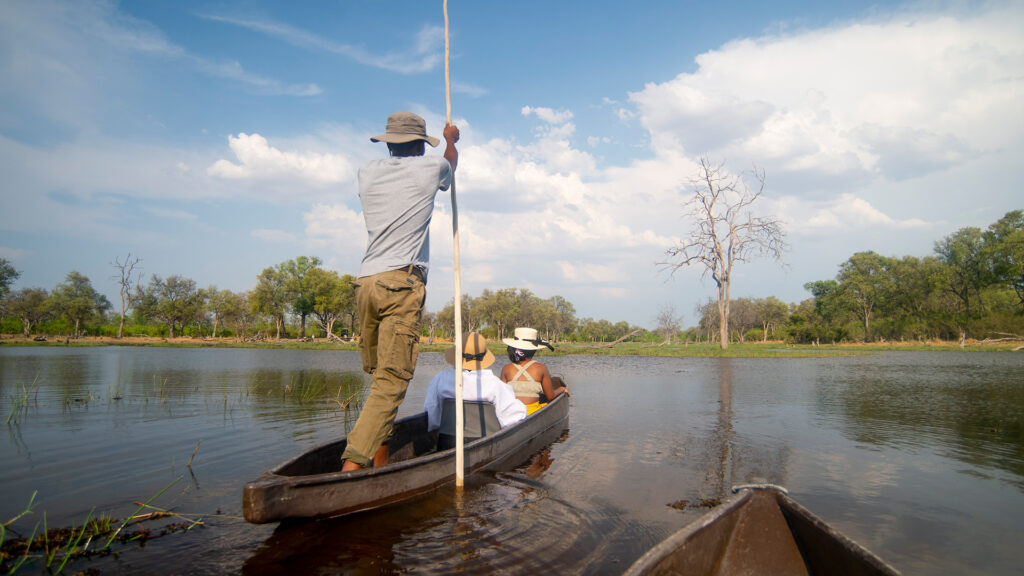
Exploring the Okavango Delta through Mokoro safaris offers a unique and immersive experience in the heart of Africa’s mesmerizing wildlife. These canoes, steered by knowledgeable guides using traditional techniques, provide a tranquil and non-intrusive way to observe animals up close.
Unlike motorized boats, mokoros allow visitors to glide silently through the water, ensuring that the wildlife remains undisturbed by human presence. This allows for incredible opportunities to witness animals in their natural habitats, as they are not scared away but rather continue with their daily activities.
The Okavango Delta is renowned for its extraordinary beauty, and Mokoro safaris offer a chance to truly appreciate its grandeur. From the small narrow channels to larger open areas, these canoes navigate effortlessly throughout the different landscapes of the Delta. With their small size but ample breadth, mokoros can access narrower regions that are inaccessible by larger boats or vehicles.
This provides a privileged vantage point for observing often hidden animal species and experiencing the Delta’s more secluded areas. For photographers in particular, mokoro safaris present an incredible opportunity to capture remarkable images of wildlife against breathtaking backdrops, creating memories that will last a lifetime.
Boating Safaris
Boating safaris in the Okavango Delta offer a unique and exciting way to explore the abundant wildlife in the area.
These safaris are particularly thrilling in the hippo-infested waterways, where you can witness these magnificent creatures up close to the safety of your boat. As you glide along the water, you will be surrounded by the sounds of nature, with birds chirping and hippos grunting in the background.
Boating safaris are like mokoro safaris but allow for a deeper exploration of the Delta’s larger waterways. This means that you can venture further into the heart of this magnificent ecosystem and have a chance to see a wider variety of animals.
One of the highlights of a boating safari is undoubtedly observing elephants and hippos bathing and drinking on the riverbanks. It is a truly magical experience to watch these massive creatures interact with their environment, providing an incredible photo opportunity for wildlife enthusiasts.
A boating safari in the Okavango Delta offers an unforgettable adventure where you can witness fascinating wildlife from a unique perspective. Whether it’s encountering hippos in their natural habitat or observing elephants by the riverbanks, these safaris provide an up-close encounter with some of Africa’s most incredible creatures.
Walking Safaris
Walking safaris offer a unique and immersive experience in the wilderness, allowing travelers to feel closer to nature and wildlife. It provides an opportunity to truly connect with the surroundings and learn about the habitats of various animal species. While some may perceive walking safaris as dangerous, it’s important to note that experienced guides prioritize safety above all else.
Guides on walking safaris go through rigorous training and are well-equipped with knowledge about the local environment and its wildlife.
They carefully assess the area before embarking on a walk to ensure that it is free from potential dangers such as predators. This precautionary measure serves as a reassurance for participants, enabling them to explore confidently without unnecessary worries.
To fully enjoy a walking safari, it is essential to place complete trust in your guide. These experts possess extensive knowledge about animal behavior and are skilled in navigating through the wilderness. With their guidance and expertise, participants can embrace this adventure knowing they are in capable hands.
By following their lead, travelers can gain a deeper appreciation for wildlife, learn fascinating facts about their natural habitats, and create unforgettable memories during their walking safari experience.
Traditional Safaris
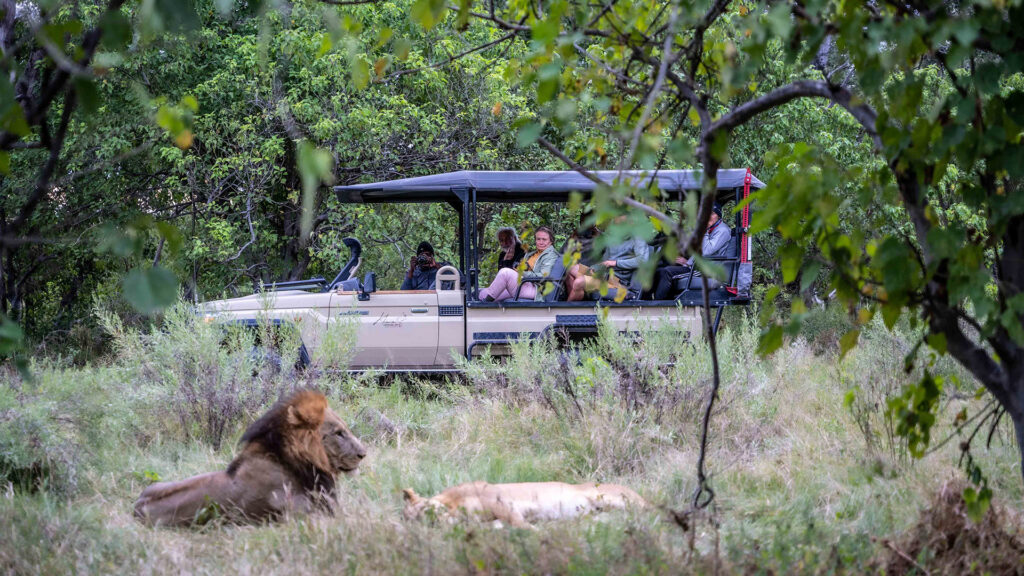
Traditional safaris offer an incredible opportunity to explore the vast grasslands and encounter a wide range of wildlife in their natural habitat. These safaris usually involve driving in a safari vehicle, allowing visitors to cover large distances and increase their chances of spotting animals.
However, when compared to safaris conducted near the ocean, traditional safaris might not provide as many opportunities for observing various species.
In areas like the Okavango Delta, where canals are prevalent, it can be challenging to get close to animals due to the muddy banks. Even with 4×4 safari vehicles, accessing certain areas becomes difficult.
Nevertheless, traditional safaris still offer plenty of encounters with different animal species. While driving through the inland areas, tourists will have numerous opportunities to see a variety of creatures that prefer sleeping on tree branches or beneath shrub covers.
Moreover, one cannot forget about the majestic felines. Lions and leopards are often found further away from the water’s edge but can still be spotted during these excursions.
Although traditional safaris may not offer as extensive diversity of wildlife as those near coastal regions do, they present ample opportunities for nature enthusiasts to witness remarkable species in action. Whether it’s observing animals resting high up in trees or encountering powerful predators like lions and leopards, traditional safaris in the Okavango Delta are sure to provide a memorable and thrilling experience.
Scenic Flights
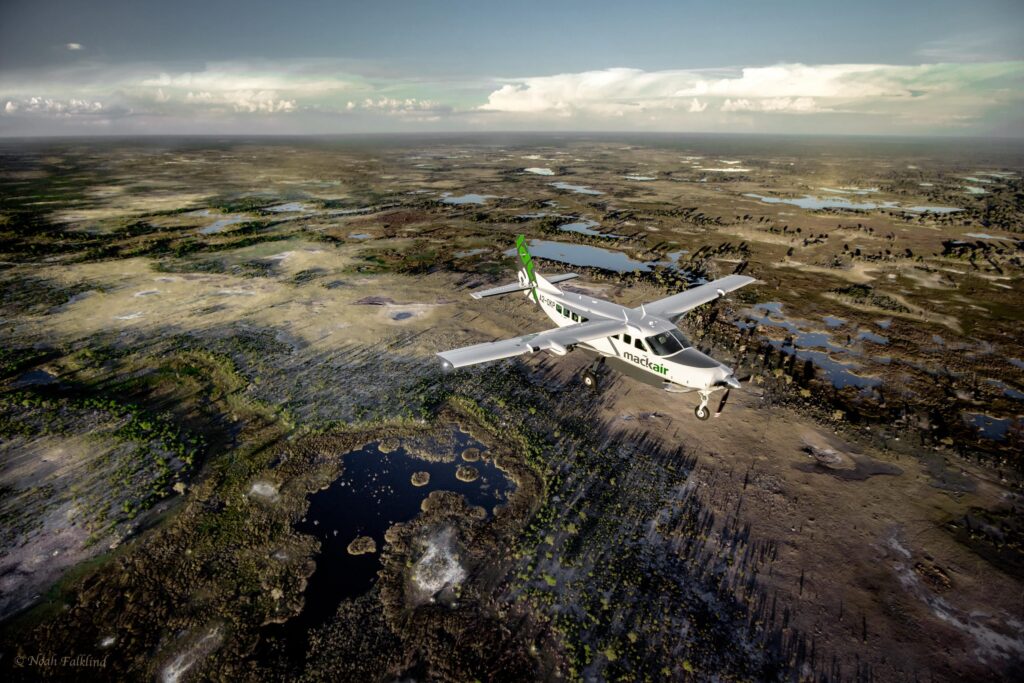
Scenic flights over the Okavango Delta offer a breathtaking perspective of this unique ecosystem. From above, travelers can appreciate the vastness and beauty of the delta, as well as spot wildlife from a whole new angle.
These flights are usually conducted in small aircraft or helicopters, allowing for a more intimate experience and unobstructed views. Pilots are knowledgeable about the area and provide commentary throughout the flight, pointing out notable landmarks and wildlife sightings.
Scenic flights are an excellent option for those who want to capture stunning aerial photographs or simply enjoy a s-eye view of the Okavango Delta. This experience offers a different perspective on the delta’s intricate network of channels, lagoons, and islands. It allows travelers to grasp the scale and complexity of this remarkable ecosystem truly.
Horseback Safaris
Horseback safaris are an exhilarating and unique way to explore the African wilderness. Imagine galloping alongside herds of wildebeests or tracking elephants through the dense brush.
These safaris offer a one-of-a-kind experience, allowing travelers to immerse themselves in the natural beauty of their surroundings while also getting up close and personal with Africa’s incredible wildlife. Riding on horseback enables visitors to access areas that may be inaccessible by vehicle or on foot, providing a truly off-the-beaten-path adventure.
While there are numerous game reserves and national parks throughout Africa, horseback safaris are only available in select locations. This exclusivity adds to the allure and appeal of these trips, attracting adventurous travelers who are seeking something different from the typical safari experience.
One such destination for horseback safaris is located at the Makgadikgadi Salt Pans in Botswana’s Kalahari Desert, north of the renowned Okavango Delta.
Here, riders can traverse vast expanses of open plains, feeling a sense of freedom as they explore this unique landscape dotted with baobab trees and teeming with diverse wildlife species. Whether you’re a seasoned equestrian or just starting a horseback safari promises an unforgettable
Birding Safaris
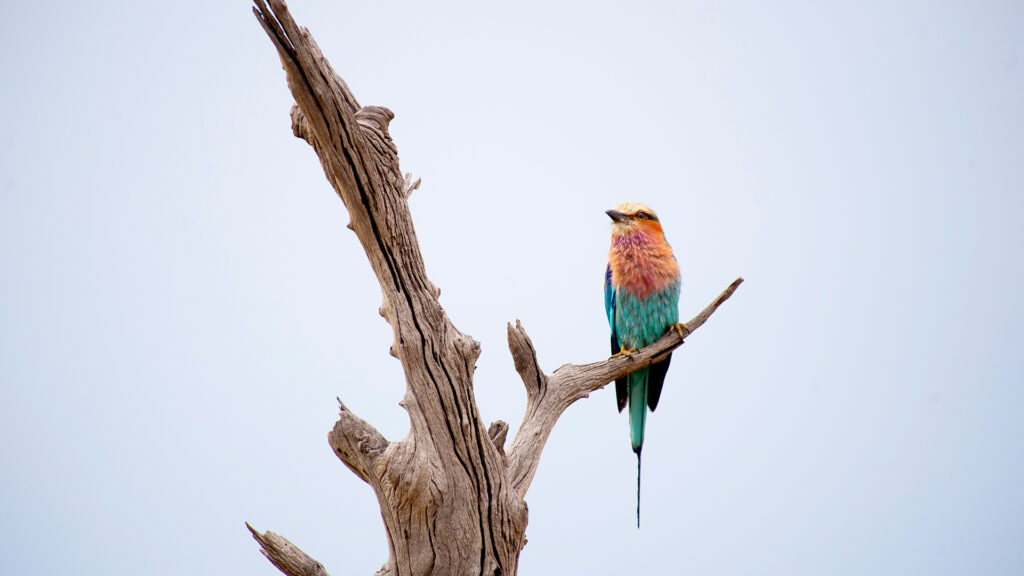
Birding safaris in the Okavango Delta offer an incredible opportunity to witness the rich diversity of bird species that call this region home. With over 400 species to spot, bird enthusiasts are sure to have a rewarding experience.
Among the notable birds found in the delta are the majestic African Fish Eagle, known for its distinct cry and regal appearance, as well as the striking, Red-Billed Hornbill with its vibrant plumage. For those seeking a rarer sighting, keep an eye out for the endangered Wattled Crane, which can be spotted in certain areas of the delta.
The best time to embark on a birding safari in the Okavango Delta is during the dry winter season from May to late July. During this time, many bird species congregate around water sources, making it easier for visitors to observe them. The lack of foliage also means that birds are less concealed, increasing your chances of spotting them.
However, if you’re interested in seeing migrating species and exploring other parts of Botswana, November to March is considered optimal. This period sees the arrival of numerous migratory birds in other areas of Botswana and offers a different perspective on bird watching in this stunning country. Whether you choose to visit during winter or migration season
Luxurious Accommodation Near the Okavango Delta
Retreat to the comfort of luxurious camps nestled within the delta’s embrace. Khwai Expeditions Camp offers unparalleled hospitality amidst the wilderness, providing the perfect blend of rustic charm and modern amenities. From guided game drives to leisurely afternoons by the pool, every moment is a celebration of the delta’s beauty.
Khwai Expeditions Camp
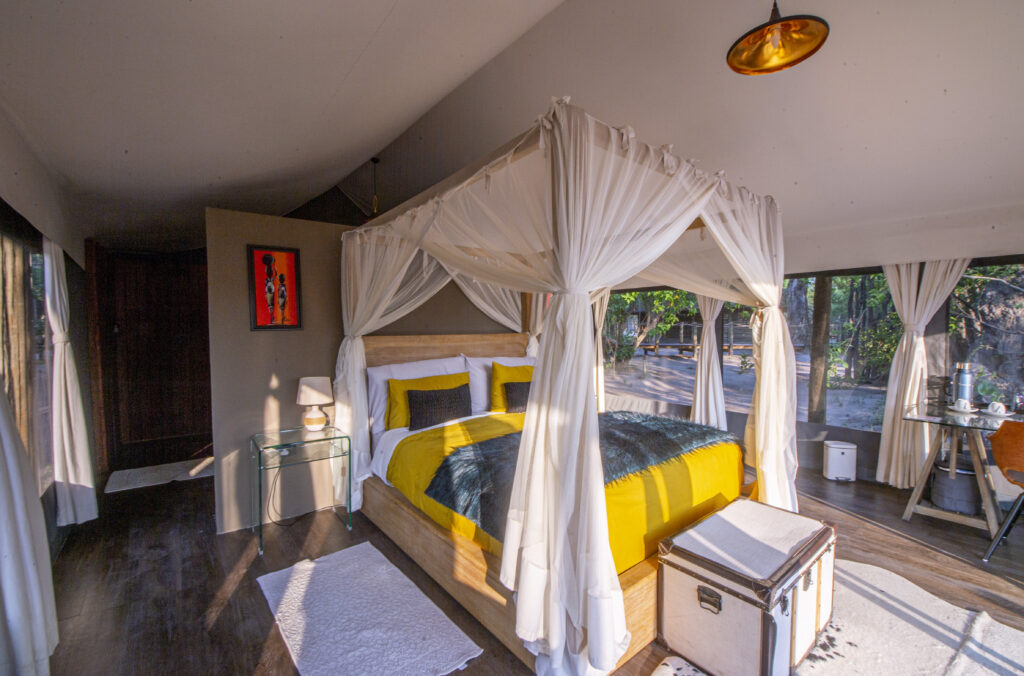
Khwai Expeditions Camp is a luxury accommodation option located near the Okavango Delta. Situated in the Khwai Community Concession, this camp offers guests a unique and immersive safari experience. The luxury camp consists of 6 spacious tents with en-suite bathrooms and private verandas, allowing guests to relax and enjoy the stunning views of the surrounding wilderness.
One of the highlights of staying at Khwai Expeditions Camp is the opportunity to go on game drives and guided walks led by experienced guides who have an in-depth knowledge of the area. This allows guests to explore the diverse wildlife that inhabits the Okavango Delta, including elephants, lions, leopards, and a variety of bird species.
Conservation and Preservation of the Okavango Delta
As a UNESCO World Heritage Site, the Okavango Delta is not just a natural wonder but a precious ecosystem in need of protection. Botswana’s commitment to conservation ensures that future generations will continue to marvel at its wonders, safeguarding the delta for years to come.
The Okavango Delta is often regarded as Africa’s most valuable wetland due to its immense ecological significance. Wetlands play a crucial role in maintaining the balance of ecosystems and ensuring the survival of various species, including humans.
The Ramsar Convention recognizes the importance of wetlands globally, highlighting their ability to remove pollutants from the environment and protect the climate. They also act as carbon sinks, storing up to 30% of all land-based carbon, and they play a vital role in water absorption, supporting food supply, and providing habitats for numerous species.
The Okavango Delta stands out due to its unique characteristics and geographical location. Situated in Botswana’s north-western region within the Okavango Highlands, it also stretches across neighboring countries. The floodwaters from the Okavango River travel deep into the Angolan Highlands before flowing through Namibia’s Caprivi Strip.
These waters eventually fill the vast sandy basin of the Kalahari Desert, forming the largest inland delta on Earth. This magnificent delta acts as a lifeline for countless species by providing them with a habitat and breeding space. It sustains an astonishing diversity of wildlife, boasting approximately 40% of all species found in Africa.
National Parks and Private Conservancies in the Okavango Delta
The Okavango Delta is known for its vast array of private conservancies and concessions, offering visitors a unique and immersive experience in this incredible ecosystem.
These private areas are set aside for conservation purposes and often have their camps and lodges, allowing guests to stay right in the heart of the delta.
This not only provides a more exclusive and intimate setting but also helps to generate funds that go directly towards supporting the conservation efforts in the area.
One of the most notable private concessions within the Okavango Delta is the Moremi Game Reserve. Spanning over 5,000 square kilometers, it is home to some of the most diverse wildlife populations in Botswana. Within Moremi, you will find various concessions, including the Mombo Concession and Chief’s Island.
These areas provide excellent game viewing opportunities with sightings of elephants, lions, giraffes, hippos, and many other species being quite common. Staying in one of the camps or lodges within these concessions allows guests to fully immerse themselves in this natural wonderland while also contributing to its preservation.
Moremi Game Reserve
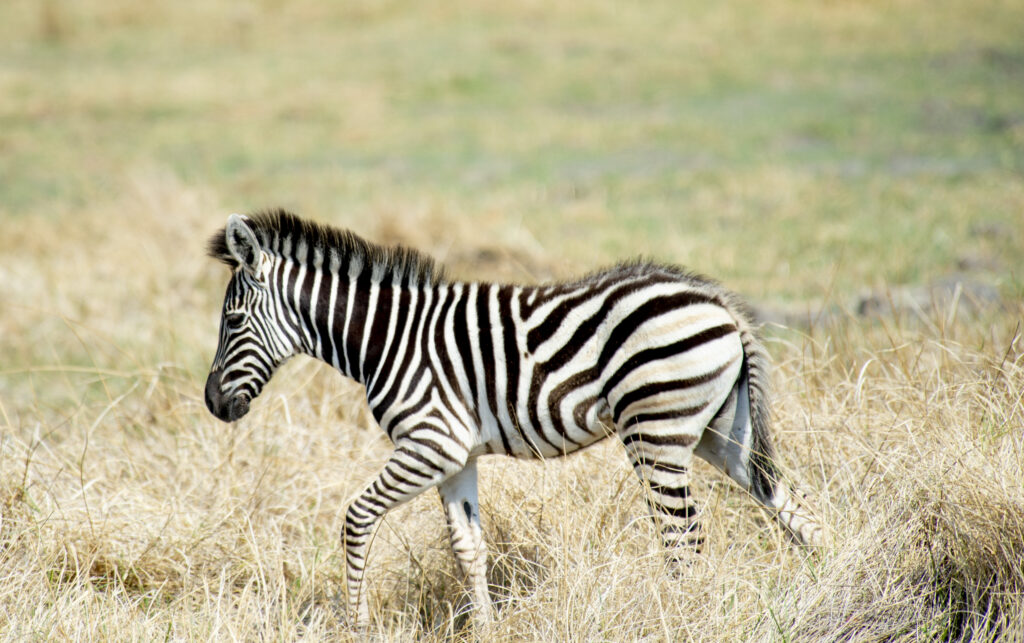
Moremi Game Reserve, located in the Okavango Delta of Botswana, stands as the only public reserve in this unique and beautiful area. Despite being relatively small, it boasts some of the most pristine and diverse ecosystems in the eastern part of the Delta.
The reserve is known for its abundant wildlife, offering visitors the chance to see a healthy population of leopards and being one of the few places in Botswana where both black and white rhinos can be spotted.
For self-drive safari enthusiasts, Moremi Game Reserve serves as the gateway to exploring the magnificent Okavango Delta.
Travelers have the flexibility to explore this biodiverse region at their own pace from the comfort of their vehicle. In addition, stunning public campsites within Moremi provide an opportunity to spend serene nights surrounded by nature’s beauty.
Although restrictions are imposed on driving off-road and after dark, these regulations ensure that wildlife conservation efforts are upheld while guaranteeing a safe and enjoyable experience for all visitors.
Moremi Game Reserve offers an exceptional opportunity to witness breathtaking landscapes and encounter a wide variety of animals in their natural habitats. Its unique position within the Okavango Delta makes it a must-visit destination for nature lovers seeking an unforgettable safari experience.
Khwai Community Concession
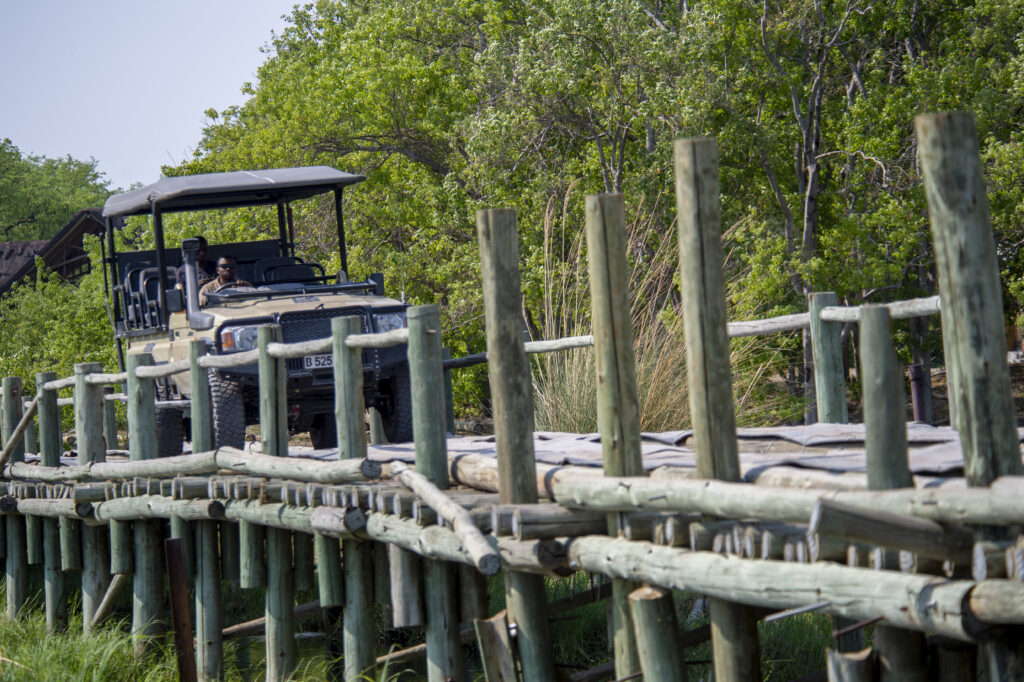
Another important area within the Okavango Delta is the Khwai Community Concession. This community-managed concession covers approximately 1,800 square kilometers and is located on the eastern border of the Moremi Game Reserve.
The Khwai Community Concession offers a unique opportunity for visitors to experience both wildlife and cultural interactions. The local community plays an active role in managing and conserving the concession, ensuring that tourism benefits both the wildlife and the people. This is where Khwai Expeditions Camp is set up. Our ultimate guide to Khwai Botswana covers just how well you can explore the wildlife-filled concession area.
In addition to these private conservancies and concessions, there are also several national parks within the Okavango Delta. The Moremi Game Reserve, mentioned earlier, is one of them. This park covers a vast area and is known for its diverse ecosystems, from floodplains and lagoons to forests and savannahs.
Chobe National Park

If you’re planning a family trip to the Okavango Delta, Chobe National Park is an excellent choice that offers a fantastic experience for both kids and adults. While it can be slightly busier compared to other parks in the area, Chobe offers numerous family-friendly activities that are sure to keep everyone entertained.
One of the highlights of visiting Chobe National Park is the opportunity to see large herds of elephants up close. Kids and adults alike will be mesmerized by the sight of these magnificent creatures as they wander freely in their natural habitat.
The park also offers various game drives and boat safaris, providing excellent opportunities for spotting a wide range of wildlife including lions, buffalos, hippos, and numerous bird species.
For elephant enthusiasts looking for a more immersive experience, visiting the Abu Concession within Chobe National Park is highly recommended. Here you will find Abu Camp, a luxurious lodge that spearheads a pioneering elephant conservation program. With this program, visitors have the unique opportunity to learn about elephant behavior and contribute to their preservation firsthand.
Guests can interact with elephants on guided walks or ride through the wilderness on elephant-back safaris while gaining valuable insights into these intelligent and fascinating creatures. It’s an educational and unforgettable experience that both kids and adults will cherish.
The Best Time to Visit the Okavango Delta
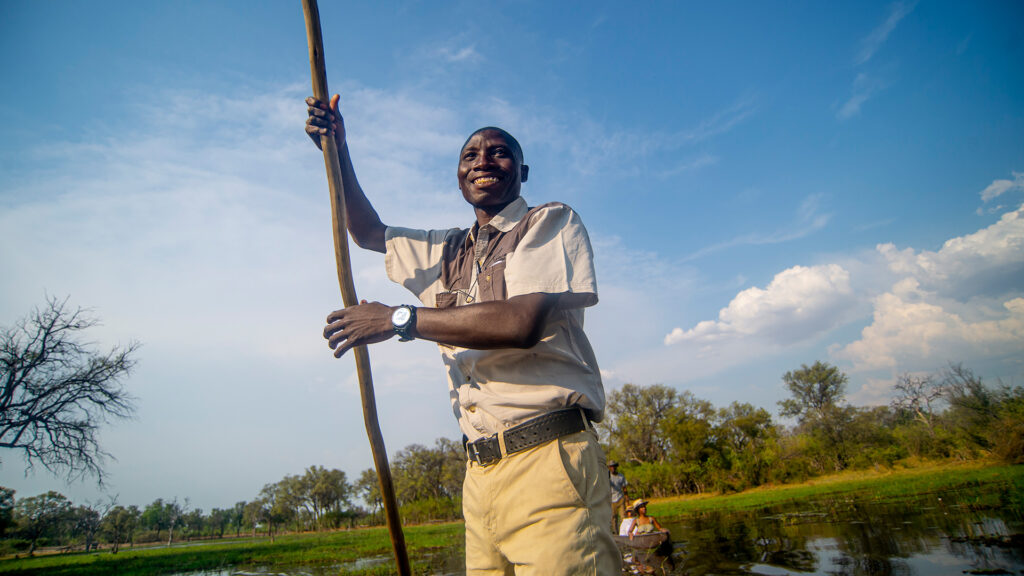
The best time to visit the Okavango Delta is during the annual flood from June to September when the lagoons and swamps are filled with water. The delta floods during Botswana’s dry season, which peaks in July and August. This period is known for its clear and dry weather, creating optimal safari conditions. The combination of sunny skies, minimal rainfall, and a high density of wildlife make it the perfect season for game viewing in the Okavango Delta.
The Okavango Delta experiences a semi-arid climate, with distinct wet and dry seasons. The wet season, from November to April, brings high temperatures and humidity, along with frequent rain and thunderstorms. In contrast, the dry season, from May to October, offers milder temperatures and lower humidity levels, making it the preferred time for wildlife viewing.
The dry season from May to October offers milder temperatures and lower humidity levels. Daytime temperatures average around 25-30°C (77-86°F), providing comfortable conditions for exploration. However, nighttime temperatures drop significantly to around 10°C (50°F), so visitors should be prepared with appropriate layers to stay warm during cooler nights.
Contrary to what one might expect, the flooding occurring during the dry season enhances the safari experience. The abundance of water attracts a wide variety of animals to gather around rivers and lagoons for drinking and grazing.
This concentration of wildlife increases the chances of spotting numerous species as they come together in search of water sources. With such favorable conditions, visitors can expect incredible game drives and boat cruises through lush landscapes teeming with elephants, lions, hippos, giraffes, and much more.
On the other hand, it’s important to note that the wet season also brings high temperatures and humidity levels. Daytime temperatures can reach highs of 30-35°C (86-95°F), making it important for visitors to stay hydrated and protected from the sun. The frequent rain and thunderstorms during this time can also lead to temporary flooding in some areas of the delta, adding even more drama to its already spectacular landscape.
No matter when you choose to visit the Okavango Delta, you are sure to be awe-inspired.
Plan Your Journey
Whether you’re an intrepid explorer or a luxury traveler, the Okavango Delta beckons with its untamed beauty and boundless adventures. From thrilling safaris to serene sunsets, every moment in the delta is a reminder of nature’s majesty. Begin your journey to this wilderness paradise and discover the magic of the Okavango Delta.
Book Khwai Expeditions Camp to Explore the Okavango Delta Channels
